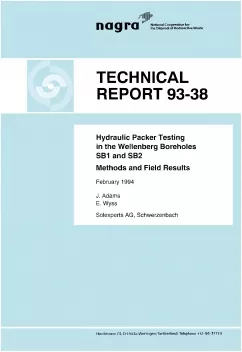
Technical Report NTB 93-38
Hydraulic Packer Testing in the Wellenberg Boreholes SB1 and SB2 Methods and Field Results
As part of the effort by the National Cooperative for the Disposal of Radioactive Waste (Nagra) to assess the suitability of various sites for construction of a repository for low-and intermediate-level radioactive waste, five boreholes were drilled at the Wellenberg site to obtain geologic and hydrogeologic data. Solexperts AG was contracted by Nagra to perform and evaluate hydraulic testing for two of the boreholes, SB1 and SB2.
The scope of work included field testing, test interpretation and reporting. The objectives of the testing program were to characterize the vertical distribution of hydraulic properties in the boreholes, to facilitate collection of formation-fluid samples from isolated test intervals and to assist in performance of borehole fluid logging. This report serves to document methods and results of the hydraulic testing program carried out in SB1 and SB2.
A total of 58 hydraulic test sequences were conducted in the boreholes; 37 in SB1 and 21 in SB2. The hydraulic test sequences were conducted primarily using single-and double-packer test systems. The test systems include a down-hole shut-in valve and triple pressure/temperature measuring probe. A Moineau pump system was incorporated in the test system when conducting constant rate withdrawal tests or for the collection of groundwater samples. Surface test equipment included: Data acquisition system, constant pressure injection system, gas and water separator, and flow measurement systems for liquid and gas.
The primary hydraulic testing methods utilized include pulse (i.e., pressurized slug), slug, constant pressure, constant rate, and pressure recovery tests. A series of individual test events constituted a test sequence for a particular test interval. The design of the test sequence used for characterizing a test interval was based on the test objectives, which were specified by a Nagra representative. The analysis approach was a combination of conventional single-event analyses and, when necessary, application of analysis and borehole simulation software that account for effects such as borehole history, temperature and preceding test events (by means of superposition).
Borehole SB1, situated at an elevation of 845 meters above sea level (m asl), was drilled vertically to a depth of 1670 meters below land surface. Transmissivity estimates for intervals tested within SB1 range between 1 E-12 m2/s and 1 E-5 m2/s. Equivalent fresh-water head levels, based on estimated static formation pressures, range from approximately 148 to 1006 m asl.
Borehole SB2, situated at an elevation of 532 m asl, was drilled vertically to depth of 1870 meters below land surface. Transmissivity estimates for intervals tested within SB2 range between 1 E-11 m2/s and 1 E-3 m2/s. Equivalent fresh-water head levels, based on estimated static formation pressures, range from approximately 485 to 750 m asl.
